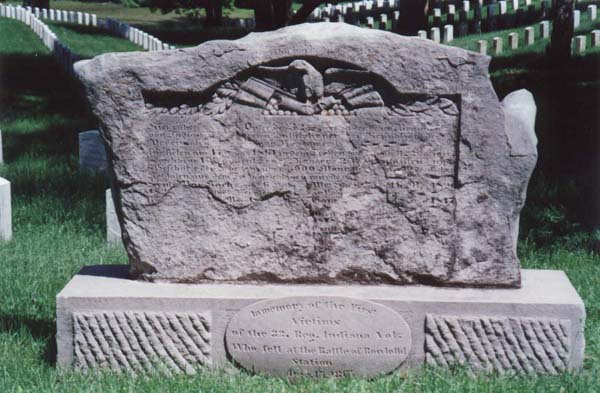
Monument to 32nd Indiana's Soldiers Killed at Rowlett's Station,Ky.
32ND INDIANA INFANTRY (1ST GERMAN)
CIVIL WAR MONUMENT PRESERVATION
AND COMMEMORATION AT LOUISVILLE
FEBRUARY 2, 2002

The Thirty-second Regiment Indiana Volunteer Infantry, also called
the First German, was composed of German immigrants (many of them
Turners) and the descendants of local German settlers. Several of
the ten companies which comprised the 32nd Indiana were formed by
Turner Clubs from all over Indiana--Indianapolis, Madison, Lafayette,
Fort Wayne, Terre Haute, Aurora, Evansville, Lawrenceburg--of
Louisville, KY and Cincinnati, Ohio. On August 24, 1861 these
volunteers were mustered at Camp Morton, Indianapolis.
August (von) Willich, the regimental commander was born November 19,
1810, in Braunsberg, Prussia. He entered the cadet house at Potsdam
when he was twelve years old and, at fifteen, the military academy
in Berlin. By the age of eighteen, he was a lieutenant in the
Prussian army and a captain three years later. Willich fought
with revolutionaries in Baden in 1848, then fled to the United
States, where he settled in New York and worked as a carpenter
in the Brooklyn Navy Yard. In 1853, he edited a labor newspaper
he founded in Cincinnati for the German speaking community. At
the request of Governor Oliver P. Morton, he assumed command of
the Thirty-second Indiana. Willich drilled his regiment, to a
high degree, in German. He earned the reputation of disciplinarian
and would direct his regiment by Prussian bugle calls on the parade
ground and battlefield.
Rebels, more than 3,000 strong, were beaten into flight from
the battlefield at Rowlett's Station by 500 German soldiers.
Lieutenant Max Sachs, leading Company "C" on the Union left
during the battle, was the one officer among the thirteen men
killed. Surrounded by Texas Rangers, Sachs and four of his men
were struck down in a blaze of gunfire after defiantly choosing
to fight rather than to surrender.
In the days following the engagement, Private August Bloedner
of Company "F," 32nd Indiana procured a large tablet of outcrop
limestone from the fields around the Green River town. He expertly
carved an account of the battle in German, including the names,
places and dates of birth of those men killed. Bloedner surmounted
the monument with a recess in which he placed patriotic symbols
including an eagle clutching a brace of cannon flanked by National
flags. The regiment placed the memorial to their comrades at the
hilltop burial site west of Munfordville, KY on the north side
of the river sometime in January 1862. In response to directives
to gather all Union dead to National Cemeteries the remains, along
with the monument, were removed from Munfordville to Cave Hill in
June 1867. The monument was mounted upright on a commemorative
base stone with the English inscription, "In memory of the First
Victims of the 32. Reg. Indiana Vol. Who fell at the Battle of
Rowlettd [sic] Station Dec. 17, 1861."
On February 2, 2002, John M. Trowbridge of the Kentucky
Military History Museum at Frankfort, directed a grave side
memorial ceremony at Cave Hill National Cemetery, located at 701
Baxter Avenue, Louisville, Kentucky. Reenactors of the 32nd
Indiana and the Bluegrass Mountain Artillery of Fort Duffield
Camp #1 were on hand to honor those men killed at the battle
of Rowlett's Station on December 17, 1861. A posting of the
colors, invocation, and dignitary remarks culminated with
a military salute and benediction.
At 1 p.m. that afternoon a symposium examined the history of the
monument, the battle and the regiment, at the German-American
Club located at 1840 Lincoln Avenue in Louisville.
-----------------------------14383212572506 Content-Disposition: form-data; name="userfile"; filename=""